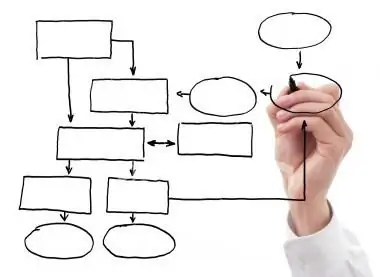2026 Author: Howard Calhoun | [email protected]. Last modified: 2025-01-24 13:10:37
In accordance with the current legislation, the head of a budgetary enterprise has the right to choose the method of accounting, including by transferring this function to centralized accounting. The main regulations governing this activity are the Tax Code, BK and Federal Law No. 129. Consider further how to centralize accounting.

Regulatory framework
In art. 162 of the BC establishes that the powers of the recipient of budget funds include independent reporting or transfer of this activity to centralized accounting departments. This provision is also provided for in paragraph 2 of Art. 6 Federal Law No. 129. The norm says that managers can transfer powers on a contractual basis. According to paragraph 5 of Art. 321.1 of the Tax Code, reporting is carried out by centralized accounting, if a budgetary enterprise carries out commercial activities. She also fills out a tax return. The document is handed over to the department of the Federal Tax Service at the address of the location of the budgetary enterprise.
Centralizedaccounting
It must be said that the current legislation regulating the issues of reporting does not affect the work of the institutions in question. In this regard, in practice, difficulties often arise that are directly related to their functioning and checks. Centralized accounting acts as a specialized unit. At the initial stage, such institutions were formed under state and local bodies - managers of budget revenues. Currently, centralized accounting is a relatively independent legal entity. She has her own property, seal, letterhead. To carry out its activities, the division uses special programs for accounting ("Business Pack", "1C: Accounting of a budgetary institution", etc.).

Documents regulating activities
The main acts in accordance with which the organizational structure of accounting is formed are the charters of enterprises, as well as the order of the head of the executive body of the subject or MO. Local documents are also published that regulate the activities of the institutions in question. They are published by the centralized accounting department of municipal institutions or budgetary state enterprises. These local acts are:
- Orders and orders of the leader.
- Work regulations.
- Collective agreement.
- Regulations on bonuses.
- Order on financialpolitics.
- Regulations on the provision of services for a fee.

Functions
The main task of the institutions under consideration is to keep records of individual expenditure items of departments belonging to certain departments (budgetary, state institution). Centralized accounting acts with them on the basis of an agreement. Assigning it to individual enterprises belongs to the powers of sectoral departments. Planning and accounting of budget expenditures, as well as funds received from entrepreneurial activities, are carried out in the context of institutions. Financing of costs is carried out from a single l / s according to a consolidated estimate. It is made up of centralized accounting. The functions of the division include work on the execution of the compiled estimates, control of the status of calculations, the safety of inventory and cash. It monitors the economical and targeted spending of finances, ensures the timeliness of the preparation of annual and periodic reports. In fact, the division implements all the main accounting services in the enterprise.
Rights of leaders
Heads of departments providing accounting services to budgetary and other departmental enterprises have the authority to manage funds. At the same time, leaders:
- Sign supply contracts.
- They receive advances for household and other needs or allow their issuance to their employees in the manner prescribed by the rules.
- Conclude laborcontracts.
- Give permission to pay expenses from the appropriations provided in the estimate.
- Use food, materials and other valuables according to established standards to meet the needs of the enterprise.
- Sign the documentation that serves as the basis for the issuance of cash, inventory and other valuables, approve reports on advance payments, acts of writing off inventory that has become unusable.
- Receive the necessary certificates and materials related to the execution of the estimate.
- Solve other issues related to the financial and economic life of the enterprise.

Classification of divisions
The executive bodies of the region or the MO can establish different levels of accounting centralization for a particular institution. Depending on this, the specific tasks of the unit are determined. For example, with full centralization, the staffing table does not provide for the position of an accountant. Accordingly, services are not formed and reporting is carried out. In this case, the unit operates relatively apart from the enterprise. An example is the centralized accounting of kindergartens. Primary documentation relating to the movement of inventories and other non-financial assets is completed by employees who are liable. Business leaders provide data on income and expenses. On their basis, the centralized accounting department of kindergartens generates estimates. The right to sign on declarations concerningthe issuance of advances by accountable employees, the approval of reporting on these payments, the certification of payroll statements for the payment of salaries, is retained by the heads of the preschool educational institution. The considered centralization scheme is currently considered the most popular. It allows you to minimize the cost of both time and money.

Partial transfer of functions
This is the second most popular scheme of centralized accounting. In this case, part of the functions is transferred to the division, and part is implemented at the enterprise itself. For example, centralized accounting can carry out settlements with contractors and suppliers, extra-budgetary funds and the budget for fees and taxes. In the staffing of the enterprise, the corresponding positions are introduced. The persons occupying them implement the rest of the functions. Their responsibilities, in particular, include the preparation of not only primary documents, but also papers that act as the basis for settlements. The latter, in particular, include staffing tables, payroll, according to the data from which the cost of inventories used in the enterprise is written off, and so on. Centralized accounting in this case is endowed with control functions. It has the right to check the correctness of the documentation provided, the validity of the tariffs and prices applied by the enterprise, to monitor compliance with the procedure for spending budgetary and other funds. Centralized accounting also carries out cashless payments, including for cathedralsand taxes, prepares financial statements.

Extra
In some cases, a budgetary institution receives maximum authority to keep records of the movement of funds. Accordingly, it provides for a special unit with competent staff. The centralized accounting department is given the right to carry out accounting for expenses that are made under separate budget items. Typically, this situation is due to the nature of the supply of inventories and other non-financial assets. Using programs for accounting, enterprises independently conduct their reporting. It is advisable to use this option to control the spending of budget funds. Institutions that have their own accounting department submit reports to industry centralized divisions. They, in turn, form consolidated documents for the region, city, district.
Checking contracts
Auditing the correctness of accounting in budgetary institutions begins with monitoring compliance with the terms of agreements for accounting services. Such contracts usually stipulate the key points of the activities of the units in question. In particular, the agreements prescribe the degree of centralization, the main functions of accounting, the obligations and rights of the parties. From the contract, the auditor receives basic information about the object of control. In addition to the obligations, rights, functions of the parties, the auditor checks the right to put the first signature. The head of a budgetary enterprise can retain it when concluding an agreementonly for profit-making activities, or for all accounts. The right to put a second signature may be granted to the chief accountant of an institution or a centralized unit. It depends on how functions are distributed between them.

Financial policy
It acts as a document for internal use. Inspectors during the inspection carry out a thorough audit of the accounting policy. It is a practical guide for employees of the financial services of the enterprise and is of particular importance to external users. Thus, arbitration courts, when making decisions on disputes, are guided by the accounting methods chosen by the institution and documented. The state financial policy is implemented according to the Instruction approved by the order of the Ministry of Finance No. 148n dated December 30, 2008. Direct accounting in the institution is carried out in accordance with Federal Law No. 129. In Art. 5 (p. 3) states that enterprises can independently form financial policies based on the specifics of their activities. Responsibility for the compilation, maintenance, timely provision of reliable and complete information lies with the chief accountant. If necessary, changes are made to the document. The correctness of their indications is checked by auditors.
Conclusion
A feature of the work of centralized accounting is the complexity of interaction with a large number of budgetary institutions. In this regard, it is extremely important for the unit to formulate the order of these relationships. One ofthe key acts are the workflow schedule. If its points are not observed or if it is absent in the accounting department, many violations occur.
Recommended:
Accounting documents are The concept, rules for registration and storage of accounting documents. 402-FZ "On Accounting". Article 9. Primary accounting documents

Proper execution of accounting documentation is very important for the process of generating accounting information and determining tax liabilities. Therefore, it is necessary to treat documents with special care. Specialists of accounting services, representatives of small businesses who keep independent records should know the main requirements for the creation, design, movement, storage of papers
Organizational structures of an enterprise - an example. Characteristics of the organizational structure of the enterprise

The implementation of plans and programs is achieved by building an organizational structure that allows you to effectively organize the joint activities of staff through the appropriate distribution of duties, rights and responsibilities. The article highlights the elements of the organizational structure, gives examples of its various types, highlights their advantages and disadvantages
What is the project structure? Organizational structure of the project. Organizational structures of project management

The project structure is an important tool that allows you to divide the entire course of work into separate elements, which will greatly simplify it
Organizational structure of Russian Railways. Scheme of the management structure of Russian Railways. Structure of Russian Railways and its divisions

The structure of Russian Railways, in addition to the management apparatus, includes various dependent divisions, representative offices in other countries, as well as branches and subsidiaries. The head office of the company is located at: Moscow, st. New Basmannaya d 2
Accounting for working hours in the summary accounting. Summarized accounting of the working time of drivers with a shift schedule. Overtime hours with summarized accounting of wor

The Labor Code provides for work with a summarized accounting of working hours. In practice, not all enterprises use this assumption. As a rule, this is due to certain difficulties in the calculation

